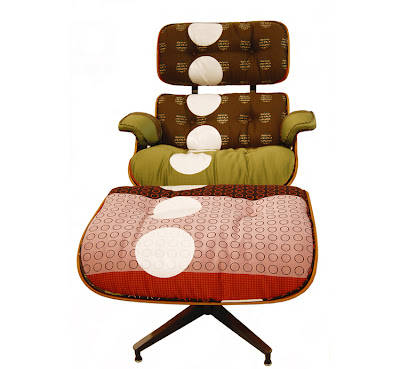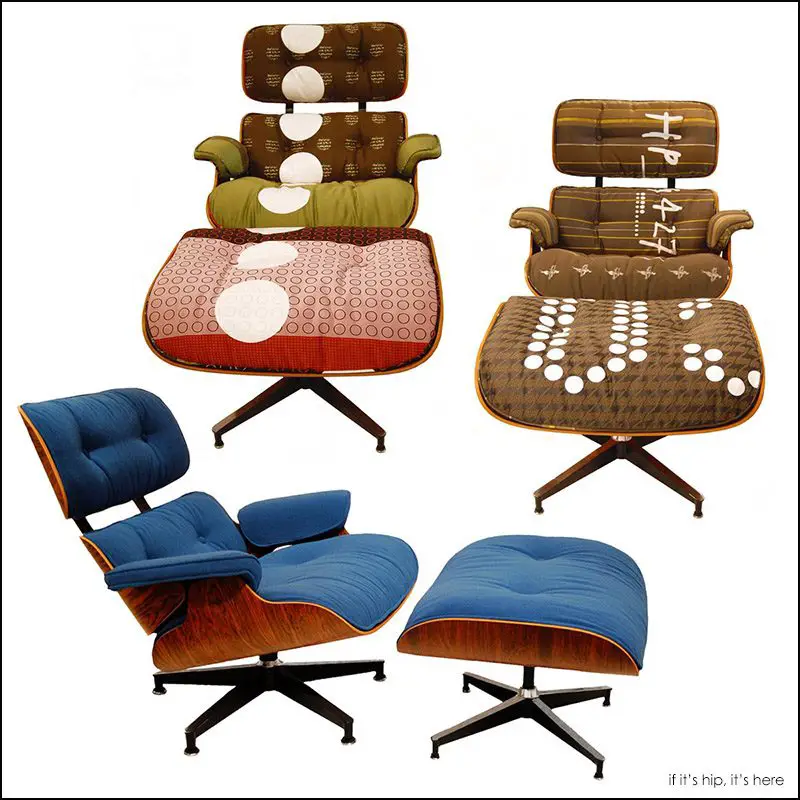Three unique vintage Eames lounge chairs and ottomans are being offered as one-offs by New York’s Moss Gallery (now Moss Bureau).
Eames lounge chairs upholstered by Hella Jongerius
Dutch designer Hella Jongerius and Moss take the 20th century icon and re-interpret these now ‘classic’ and ubiquitous symbols of Modernism as part of a one-off collection of special upholstered pieces they are collaborating on with Maharam. Over time, Moss hope to create an expanding dialogue between Maharam’s contemporary textiles and strong iconic works from Moss’ collective object-history.

These rare, vintage Eames lounge chairs and ottomans are produced in Brazilian rosewood veneers, the original wood chosen by Charles and Ray Eames for the iconic chair when it was put into production in 1956. In 1992, Herman Miller ceased producing the chair in Brazilian rosewood due to a worldwide embargo on the endangered species.


above:
designers – Charles Eames and Ray Eames
design year – 1956
manufacturer – Herman Miller, USA
materials – Brazilian rosewood; aluminium; upholstered with Maharam Repeat Dot fabric (55% Cotton; 24% Polyester, 21% Rayon)
The third is another vintage Eames lounge chair and ottoman made with Brazilian rosewood and aluminium. Moss has upholstered this special chair and ottoman in ‘Voyage’ fabric, a rich blue wool produced by the renowned textile house Maharam. As with many of their textiles, the fabric is produced with reduced environmental impact and is ‘Greenguard’ certified for reduced indoor air emission.:

above:
designers -Charles Eames and Ray Eames
design year – 1956
manufacturer – Herman Miller, USA
materials – Brazilian rosewood; aluminium; upholstered with Maharam ‘Voyage’ (100% wool)
dimensions:
chair: 32.75″ x 32.75″, height: 32″
ottoman: 26″ x 21.5″, height: 17.25″
price for each:
$12,000.00
buy any of the three here
Maharam
Maharam, a fourth generation family-run business, celebrated its centennial in 2002. First renowned as a supplier of theatrical textiles, in the 1960s Maharam pioneered the contract textile concept, developing engineered textiles for commercial application. Though performance is an essential element of every product, Maharam continues to create innovative textiles through the exploration of pattern, material and technique.
Maharam pursues a holistic approach to design, embracing a range of disciplines as fundamental to its business philosophy; showrooms, graphics and accessories receive the same attention to detail as product design.
The Maharam Design Studio is responsible for the development of Maharam’s extensive textile collection, ranging from re-editions of enduring designs of the twentieth century’s most noted visionaries to fashion-forward concepts and materials. The Maharam Design Studio maintains a strong focus on new technologies and cultural markers, often finding inspiration beyond the textile industry, including collaborations with avant-garde industry outsiders. Conceived to foster an open dialogue across varied design disciplines, these collaborative projects also serve to introduce a fresh perspective and unexpected media into the world of textiles.
Maharam has textile designs in their collection designed by both Charles Eames (Dot Pattern) and Hella Jongerius (Repeat and Layers).

In the above book, Maharam Agenda, Maharam takes a holistic view of design, embracing a range of disciplines including architecture and interiors, furniture, fashion, accessories, graphic and digital media. The Maharam Design Studio oversees the cultivation of an extensive textile collection, ranging from re-editions of enduring designs by the twentieth century’s most noted visionaries to textile-based collaborations with industry outsiders including Konstantin Grcic, Hella Jongerius, Maira Kalman, Bruce Mau, Jasper Morrison, Nike and Paul Smith, among others. The publication provides a comprehensive overview of the company’s history, cultural markers and design projects. Abstracted product applications are featured through “Useless Objects,” a collaboration with Jasper Morrison.
You can buy this first edition 2011 hardcover book here
